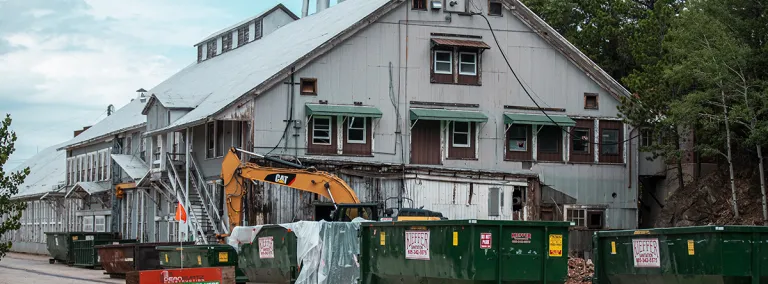Sanford Lab moves forward with Maintenance Support Facility
Removal of three old buildings began in early July; construction on new facility to begin in late summer
Early in July, crews began the process of removing three buildings at the Sanford Underground Research Facility. The buildings—Machine Shop, Motor Shop and Iron House—were used during mining operations. However, since 2002, the shops have been either empty or used as cold storage.
The old shop buildings will be replaced by a new Maintenance Support Facility, a 25,000-square-foot structure that will provide shop space for maintenance activities, a warehouse, offices and meeting spaces. Funding for the project was provided by both the previous and current governors of the State of South Dakota.
“We are very grateful to Gov. Kristi Noem and former Gov. Dennis Daugaard for their strong financial support of this project and the important work that is being done at Sanford Lab,” said Mike Headley, South Dakota Science and Technology Authority (SDSTA) executive director.
Construction of the new facility is slated to begin in late summer. Architect Steve Williams of Williams and Associates in Spearfish, developed a design that is respectful of the rich Homestake legacy, incorporating many exterior features similar to the former building. As a result, the construction plans were quickly approved by the Lead Historic Preservation Committee and the State Historic Preservation Office.
SDSTA explored the possibility of rehabilitating the existing structures, but a closer look revealed the buildings did not meet the functional requirements for the future needs of facility operations. SDSTA did, however, document the old structures, hiring Quality Services to preserve the site through photography. Additionally, existing building materials such as the large structural timbers in the existing shops will be preserved to the extent possible for future use.
“We care about the history of Lead and mining and want to ensure everything is documented,” said Pam Hamilton, Sanford Lab project manager. “In addition to the timbers, we are identifying other existing building materials that will enhance the design of the new structure.”
The new building will be much taller—30 feet on one side with a crane hook height of 16 feet. At 25,000 square feet, the new building will be slightly smaller than the existing buildings, but it will also free up yard space, creating room for a loading dock. An added bonus? Delivery traffic will be able to bypass residential neighborhoods. The new building will also offer a centralized location for the maintenance crews and their tools.
“Since SURF began operating in 2008, the maintenance groups have been located in various buildings throughout the site,” said Tim Baumgartner, director of facility infrastructure at Sanford Lab. “With this new structure, the maintenance crews will also have a training area, computer work stations and a break room in a new consolidated facility. We look forward to the new building and the increased safety and communications that will result from this effort.”
“We’re excited to start this project and continue Sanford Lab’s advancement as a world-class research facility,” Headley said.
